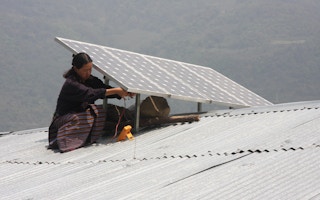2021 is a pivotal year for Asia’s energy transition. As the region claws its way out of the Covid-19 crisis, renewables could drive the economic recovery, creating green jobs and ensuring energy security. Meanwhile, pressure is piling on governments to commit to tougher climate action ahead of the upcoming United Nations Climate Change Conference, or COP26.
But from hostile regulatory environments to unreliable power grids, Asia’s nascent clean energy markets still face significant barriers. Despite their increasingly attractive price tag, a policy push is needed for renewables to gain ground. Here are four issues that need to be addressed this year to put the region’s energy sector on a greener path.
1. Place efficiency front and centre of post-pandemic recovery
Energy efficiency is essential to achieving climate goals. That’s because measures to cut energy intensity in buildings, industry, and vehicles must deliver almost half of the reduction in planet-heating emissions needed. That requires upgrades of homes, manufacturing equipment and appliances, which requires investment.
Already lagging, progress on efficiency suffered a setback from the pandemic as uncertainty about future revenue and low power prices made firms squeamish about investing in new technologies, shows a new report by the International Energy Agency (IEA). Over the past five years, efficiency improvements have been falling.
Experts have called on governments to include efforts to bolster efficiency in recovery packages, highlighting their strong potential to create jobs and prop up economies battered by the crisis. But Asian nations account for only a sliver of stimulus spending for efficiency announced worldwide. As the region’s energy demand keeps increasing in the post-pandemic era, so must its efforts to do more with less.
2. Clean up policy environments
Policy incentives and robust frameworks play a critical role in drawing clean energy investment and driving market growth. Across Asia, renewables continue to fight an uphill battle. Hamstrung by regulatory roadblocks, solar and wind firms struggle to access land and power grids, reach agreements with energy planners, and get financiers on board.
In Southeast Asia, the sector is governed particularly poorly. Clean energy policies often fall within the scope of various institutional bodies with limited resources, leading to fragmented regulatory environments and unclear responsibilities. Negotiations between governments and developers can be cumbersome, with some nations yet to introduce pricing mechanisms.
Even in some of Asia’s economic powerhouses—such as Japan and South Korea—policies on land use and grid connections hurt renewables, while looming regulatory uncertainties in China are projected to slow wind deployment in 2022. In South Asia, Bangladesh has failed to adopt financial incentives for clean energy firms, while Pakistan’s long-term power development plans have largely underestimated the potential of renewables, although the nation’s recently announced plan to freeze new coal projects signals change.
According to the IEA, adequate government support and conducive frameworks could see global solar and wind additions each rise by a staggering 25 per cent next year, with China alone accounting for 30 per cent of the increase. But if regulatory uncertainties persist, capacity additions could be significantly lower, threatening to derail climate commitments.
3. Make smart investments
Amid sharply falling renewables costs, governments across the region need to think long-term and be savvy about where they put their money. Experts have stressed that new coal-fired power ventures now come with significant economic risks. They warn that power plants could be shut down early, resulting in millions in financial losses.
A 2020 report by research group Wood Mackenzie found most markets in Asia Pacific will see the levelised cost of electricity (LCOE) for renewables drop below coal’s this decade. South Korea, Thailand and Vietnam are expected to join China with lower clean energy costs compared to coal as early as this year.
Alleviating concerns over the intermittency of green power, a new Bloomberg analysis shows the average cost of a lithium-ion battery pack fell 88 per cent over the past decade, and 13 per cent last year alone. Wood Mackenzie estimates solar projects coupled with storage will be competitive with gas by 2026.
But should governments implement bolder carbon pricing—at levels around US$30 per tonne of carbon dioxide—solar and onshore wind are set to beat coal on cost much earlier, by 2023 and 2030, respectively. An IEA report found last year that solar is now the cheapest source of electricity in history.
As political tides shift, Asia Pacific’s switch to renewables has gone from an environmental necessity to an economic inevitability. Building wind and solar facilities and upgrading electricity grids now often makes more financial sense than subsidising dirty fuels and growing one’s coal power fleet. As does investing in green hydrogen research and development, putting in place cross-border transmission infrastructure, and adopting storage solutions to manage fluctuating clean energy supply.
4. Groom tomorrow’s clean energy workers, and support a just transition for fossil fuel employees
Renewables create employment up and down supply chains. A recent report by the International Renewable Energy Agency (IRENA) shows that clean energy accounted for an estimated 11.5 million jobs worldwide in 2019, up from 11 million the previous year. Home to the bulk of the world’s solar photovoltaic panel manufacturing, Asia accounted for 63 per cent of total jobs in renewables globally.
There will be plenty more employment opportunities as the energy transition accelerates in the years to come. The wind industry alone expects an additional 2.4 million jobs by 2024. But in order for fossil fuel workers and fresh graduates to take advantage of them, countries must build the skills base for the transition, offering more government-funded vocational training and remote learning opportunities.
From Indonesia’s coal mines and Singapore’s oil refineries to South Korea’s power plant makers, Asia is home to a range of industries that need to brace for disruption as the region changes course. Helping fossil fuel workers find green jobs will be key to ensuring the energy transition leaves no one behind.











